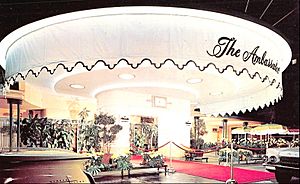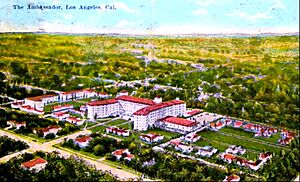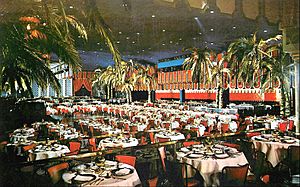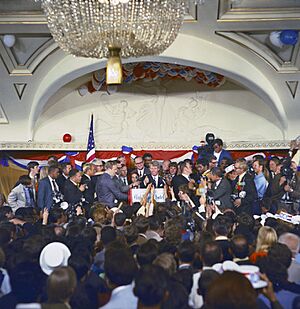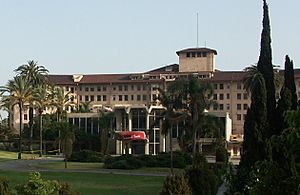Ambassador Hotel (Los Angeles) facts for kids
| Ambassador Hotel | |
Quick facts for kids 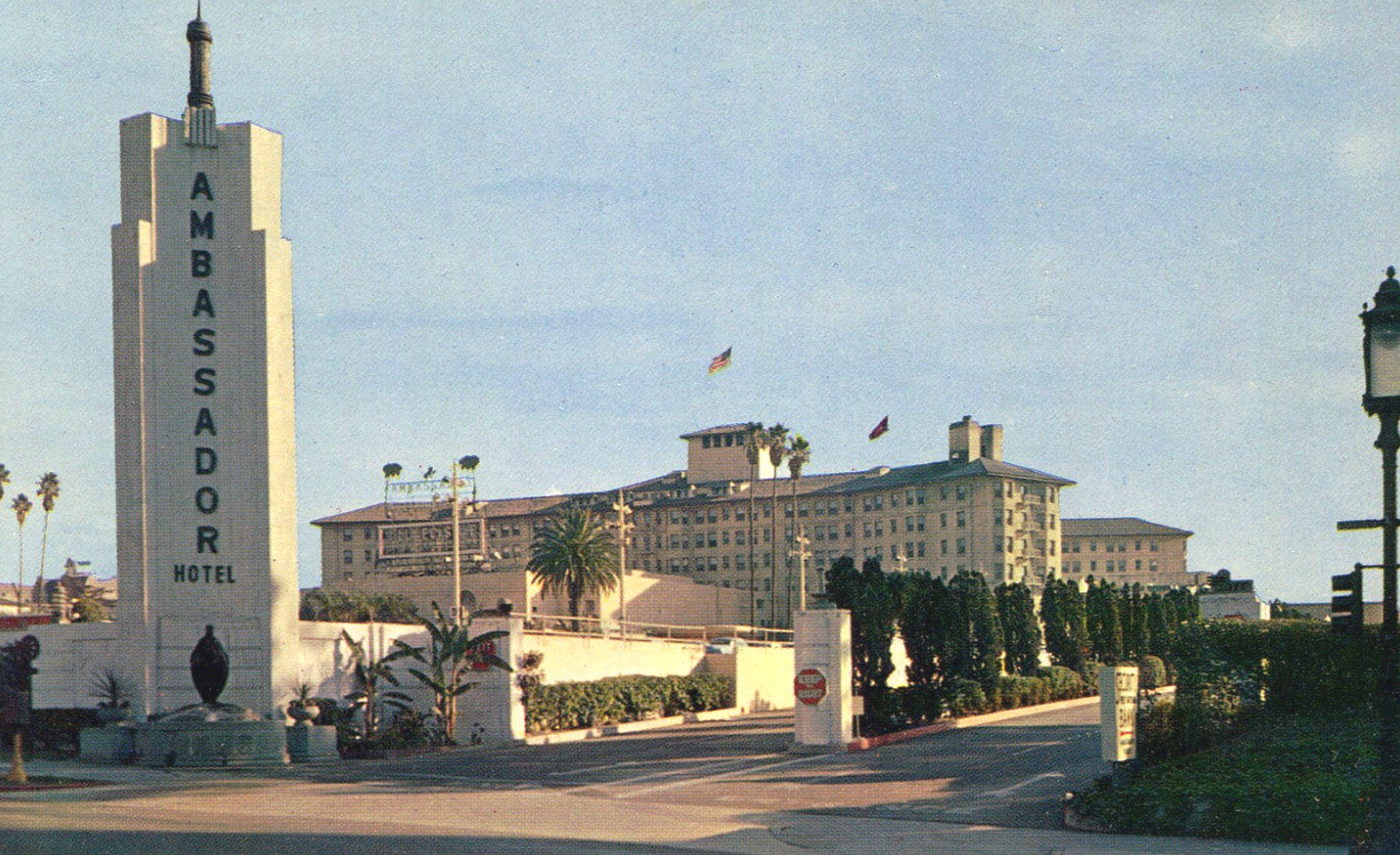 Entrance gate of the Ambassador Hotel in 1959 |
|
| Hotel facts and statistics | |
|---|---|
| Location | 3400 Wilshire Boulevard Los Angeles, California United States |
| Coordinates | 34°03′35″N 118°17′50″W / 34.05972°N 118.29722°W |
| Opening date | January 1, 1921 |
| Closing date | 1989 |
| Architect | Myron Hunt (1921) Paul Williams (1949) |
| Management | Ambassador Hotel Corporation (1921) Schine family |
| Owner | Schine family |
| No. of rooms | 1,000 |
The Ambassador Hotel was a very famous hotel in Los Angeles, California. It opened its doors on January 1, 1921. The hotel was designed by architect Myron Hunt. Later, architect Paul Williams made some updates in the late 1940s.
The Ambassador Hotel was home to the Cocoanut Grove nightclub. This was a top spot in Los Angeles for many years. It hosted six Oscar ceremonies. Also, every United States president from Herbert Hoover to Richard Nixon visited the hotel. Many famous people from movies and music also visited or performed at the Cocoanut Grove.
A very sad event happened at the hotel on June 5, 1968. United States Senator Robert F. Kennedy, a famous politician, was shot there. He passed away the next day. This event, along with changes in the area, led to the hotel's decline. The Ambassador Hotel closed to guests in 1989.
In 2001, the Los Angeles Unified School District (LAUSD) bought the property. They wanted to build new schools there. After some legal discussions about saving the historic hotel, a decision was made. Demolition of the Ambassador Hotel began in 2005 and finished in early 2006.
Contents
A Look Back at the Ambassador Hotel
The Ambassador Hotel was located at 3400 Wilshire Boulevard in Los Angeles. It sat on 24 acres of land. This large property included the main hotel building, a garage, and many separate bungalows. Today, this area is known as Koreatown.
The Ambassador was part of a group of hotels called the Ambassador Hotels System. When it first opened, the chain had hotels in Los Angeles, Santa Barbara, Atlantic City, and New York. The Schine family owned the Los Angeles Ambassador Hotel from its opening until 1971.
The hotel was a favorite place for many celebrities. Some, like Pola Negri, even lived there. From 1930 to 1943, the hotel hosted six Academy Awards ceremonies. Many U.S. presidents, from Hoover to Nixon, also stayed at the Ambassador. Leaders from other countries visited too.
The hotel's famous Cocoanut Grove nightclub was a hotspot for decades. It welcomed many well-known entertainers. Stars like Lucille Ball, Charlie Chaplin, Nat King Cole, Marilyn Monroe, Frank Sinatra, and The Supremes visited or performed there. Important movie studio leaders also spent time at the Cocoanut Grove.
The Hotel's Story Through the Years
Opening Day and Early Glamour
The Ambassador Hotel was designed by American architect Myron Hunt. It officially opened at midnight on January 1, 1921. The hotel quickly became known for its amazing luxury. Guests entered a grand lobby with a huge Italian fireplace. Crystal chandeliers, fancy carpets, and beautiful drapes decorated the space. The hotel offered 1,000 guestrooms and bungalows.
The Cocoanut Grove nightclub opened on April 21, 1921. It quickly became the center of the hotel's social scene. The club had a unique Moroccan style with gold leaf and etched palm tree doors. Inside, there were papier-mâché cocoanut trees with stuffed monkeys. These trees and monkeys were actually props from the 1921 silent film The Sheik. Stars twinkled in the blue ceiling, and a Hawaiian moon hung over a painted waterfall.
The Cocoanut Grove was a very popular place. Joan Crawford and Carole Lombard often competed in Charleston dance contests there. Carole Lombard was even discovered at the Grove. The hotel and its nightclub became symbols of glamour. Many other bars and clubs across the United States copied the "Cocoanut Grove" name.
Starting in 1928, Gus Arnheim led the Cocoanut Grove Orchestra. They played many songs each night. At one point, their music was even broadcast on the radio for two hours. The 1939 Academy Awards ceremony was held in the Cocoanut Grove on February 29, 1940. Bob Hope hosted the awards that night. The 1953 Golden Globe Awards also took place at the hotel.
During World War II, the hotel hosted many events to help the war effort. U.S. servicemen and movie stars often met there. Loyce Whiteman, a singer for the Cocoanut Grove Orchestra, remembered the club as "a house full of stars."
A Sad Event and the Hotel's Decline
On June 5, 1968, a very sad event occurred at the Ambassador Hotel. United States Senator Robert F. Kennedy had just won the California Democratic presidential primary election. He gave a victory speech to his supporters in the Embassy Room. After his speech, he was shot in the pantry area of the hotel's main kitchen. He passed away the next day at Good Samaritan Hospital.
This tragic event marked a turning point for the hotel. The area around the Ambassador Hotel also began to change. It became less popular in the late 1960s and 1970s. In 1970, the classic Cocoanut Grove was updated and renamed the "Now Grove." This was an attempt to attract a new crowd. However, people lost interest in both the hotel and the neighborhood. The Ambassador Hotel slowly fell into disrepair.
The Ambassador Hotel closed its doors to guests in 1989. However, it remained open for filming movies and hosting private events. In 1991, Donald Trump, who owned the hotel for a short time, sold off many of its items. These included silver platters, tiki-style soup bowls from the Cocoanut Grove, and furniture from the rooms.
Efforts to Save the Hotel
In 2004 and 2005, there was a big legal discussion about the Ambassador Hotel. The Los Angeles Unified School District (LAUSD) wanted to build a school on the site. But groups like the Los Angeles Conservancy wanted to save the historic hotel. They hoped to include parts of it in the new school.
The Location Managers Guild worked with students from Jefferson High School Academy of Film and Television. In March 2005, they held an event called Last Looks: The Ambassador Hotel. Students learned about finding film locations by exploring the hotel one last time. Their photos were later shown at Los Angeles City Hall.
After many legal talks, an agreement was reached in August 2005. This allowed the hotel to be torn down. In return, $4.9 million was set aside to help save other historic school buildings in Los Angeles.
The Hotel's Final Days
On September 10, 2005, a final public auction was held for the hotel's remaining items. Demolition began soon after. By January 16, 2006, most of the Ambassador Hotel was gone. Only a small part remained, including the hotel's entrance, a shopping area, a coffee shop, and the Cocoanut Grove. These parts were supposed to be saved and used in the new school. A ceremony to remember the hotel was held on February 2, 2006.
The Cocoanut Grove had been changed many times over the years. This meant much of its original design was lost. It was planned to become the auditorium for the new school. The ground floor coffee shop, designed by architect Paul Williams, was also meant to be saved. However, studies showed that the Cocoanut Grove was weaker than expected. It could not be used in the school or moved safely. In 2004, the LAUSD decided to tear down most of the Cocoanut Grove. Only the hotel entrance and one wall of the Grove were kept. After more legal discussions, demolition of these last parts began on January 22, 2008.
New Schools for the Community
Today, the site of the Ambassador Hotel is home to new schools. These are the Central Los Angeles New Learning Center #1 K–3 and the Central Los Angeles New Learning Center #1 4–8/HS. There is also the Robert F. Kennedy Inspiration Park.
The six schools built on the site are now known as the Robert F. Kennedy Community Schools. The school for younger children (K–3) opened on September 9, 2009. The schools for older students (4–8 and high school) opened on September 14, 2010. The north side of the new school looks a bit like the original hotel. The lawns facing Wilshire Boulevard also remain similar to how they once were.
See also
 In Spanish: Hotel Ambassador para niños
In Spanish: Hotel Ambassador para niños


